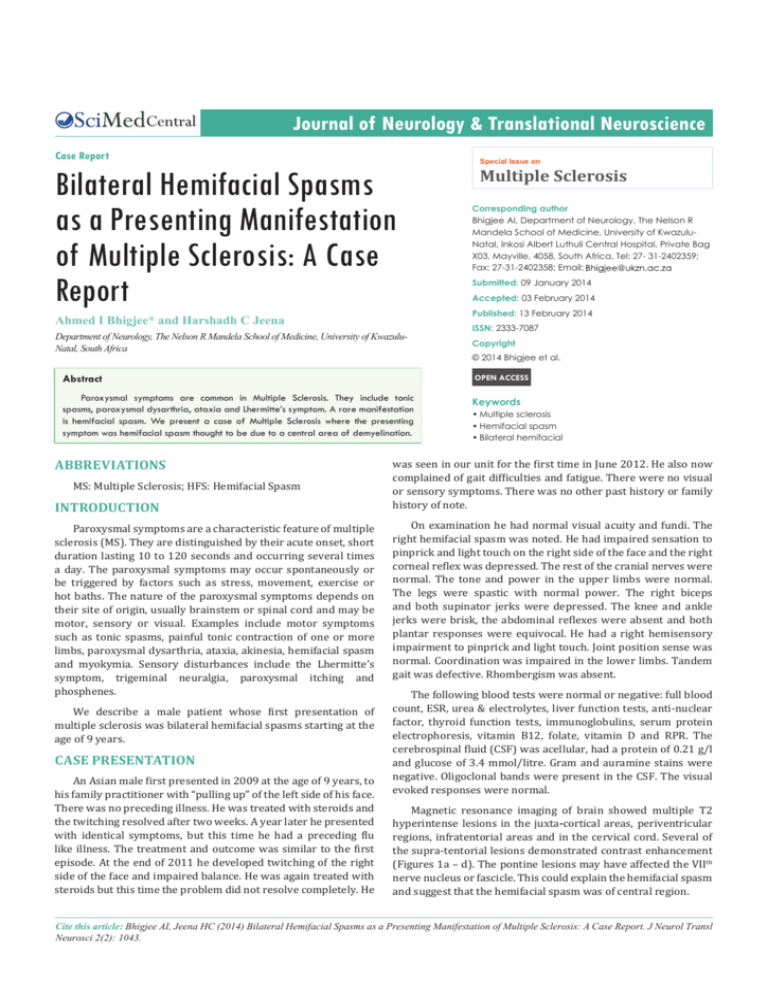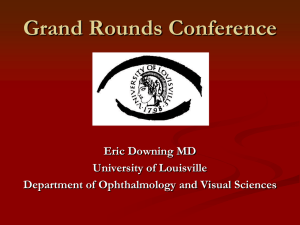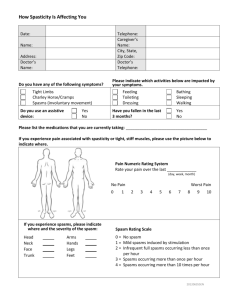Bilateral Hemifacial Spasms as a Presenting
advertisement

Central Journal of Neurology & Translational Neuroscience Case Report Bilateral Hemifacial Spasms as a Presenting Manifestation of Multiple Sclerosis: A Case Report Ahmed I Bhigjee* and Harshadh C Jeena Department of Neurology, The Nelson R Mandela School of Medicine, University of KwazuluNatal, South Africa Special Issue on Multiple Sclerosis Corresponding author Bhigjee AI, Department of Neurology, The Nelson R Mandela School of Medicine, University of KwazuluNatal, Inkosi Albert Luthuli Central Hospital, Private Bag X03, Mayville, 4058, South Africa, Tel: 27- 31-2402359; Fax: 27-31-2402358; Email: Submitted: 09 January 2014 Accepted: 03 February 2014 Published: 13 February 2014 ISSN: 2333-7087 Copyright © 2014 Bhigjee et al. Abstract OPEN ACCESS Paroxysmal symptoms are common in Multiple Sclerosis. They include tonic spasms, paroxysmal dysarthria, ataxia and Lhermitte’s symptom. A rare manifestation is hemifacial spasm. We present a case of Multiple Sclerosis where the presenting symptom was hemifacial spasm thought to be due to a central area of demyelination. Keywords ABBREVIATIONS MS: Multiple Sclerosis; HFS: Hemifacial Spasm INTRODUCTION Paroxysmal symptoms are a characteristic feature of multiple sclerosis (MS). They are distinguished by their acute onset, short duration lasting 10 to 120 seconds and occurring several times a day. The paroxysmal symptoms may occur spontaneously or be triggered by factors such as stress, movement, exercise or hot baths. The nature of the paroxysmal symptoms depends on their site of origin, usually brainstem or spinal cord and may be motor, sensory or visual. Examples include motor symptoms such as tonic spasms, painful tonic contraction of one or more limbs, paroxysmal dysarthria, ataxia, akinesia, hemifacial spasm and myokymia. Sensory disturbances include the Lhermitte’s symptom, trigeminal neuralgia, paroxysmal itching and phosphenes. We describe a male patient whose first presentation of multiple sclerosis was bilateral hemifacial spasms starting at the age of 9 years. CASE PRESENTATION An Asian male first presented in 2009 at the age of 9 years, to his family practitioner with “pulling up” of the left side of his face. There was no preceding illness. He was treated with steroids and the twitching resolved after two weeks. A year later he presented with identical symptoms, but this time he had a preceding flu like illness. The treatment and outcome was similar to the first episode. At the end of 2011 he developed twitching of the right side of the face and impaired balance. He was again treated with steroids but this time the problem did not resolve completely. He •Multiple sclerosis •Hemifacial spasm •Bilateral hemifacial was seen in our unit for the first time in June 2012. He also now complained of gait difficulties and fatigue. There were no visual or sensory symptoms. There was no other past history or family history of note. On examination he had normal visual acuity and fundi. The right hemifacial spasm was noted. He had impaired sensation to pinprick and light touch on the right side of the face and the right corneal reflex was depressed. The rest of the cranial nerves were normal. The tone and power in the upper limbs were normal. The legs were spastic with normal power. The right biceps and both supinator jerks were depressed. The knee and ankle jerks were brisk, the abdominal reflexes were absent and both plantar responses were equivocal. He had a right hemisensory impairment to pinprick and light touch. Joint position sense was normal. Coordination was impaired in the lower limbs. Tandem gait was defective. Rhombergism was absent. The following blood tests were normal or negative: full blood count, ESR, urea & electrolytes, liver function tests, anti-nuclear factor, thyroid function tests, immunoglobulins, serum protein electrophoresis, vitamin B12, folate, vitamin D and RPR. The cerebrospinal fluid (CSF) was acellular, had a protein of 0.21 g/l and glucose of 3.4 mmol/litre. Gram and auramine stains were negative. Oligoclonal bands were present in the CSF. The visual evoked responses were normal. Magnetic resonance imaging of brain showed multiple T2 hyperintense lesions in the juxta-cortical areas, periventricular regions, infratentorial areas and in the cervical cord. Several of the supra-tentorial lesions demonstrated contrast enhancement (Figures 1a – d). The pontine lesions may have affected the VIIth nerve nucleus or fascicle. This could explain the hemifacial spasm and suggest that the hemifacial spasm was of central region. Cite this article: Bhigjee AI, Jeena HC (2014) Bilateral Hemifacial Spasms as a Presenting Manifestation of Multiple Sclerosis: A Case Report. J Neurol Transl Neurosci 2(2): 1043. Bhigjee et al. (2014) Email: Central A) B) C) D) Figure 1 A) Axial T2 scan through the pons showing multiple hyperintense lesions. Arrows highlight only some of the lesions. B) Sagittal T2 scan showing multiple lesions in the pons (thick arrows) and in the corpus callosum (thin arrows). The arrows highlight only a few of the lesions. C & D) Coronal T1 scans with contrast, shows multiple enhancing lesions in the cerebral hemispheres (arrows). A diagnosis of multiple sclerosis was made and patient commenced on interferon β1 (Betaferon) 8 miu subcutaneously on alternate days. For the hemifacial spasm he was given Carbamazepine (Tegretol CR) in escalating doses. The patient improved clinically. A repeat MRI done six months later showed fewer T2 hyperintense lesions and no enhancing lesions. DISCUSSION Hemifacial spasm refers to involuntary, irregular contraction of the muscles supplied by the VIIth cranial nerve. The spasm usually starts at the lower eyelid and then spreads to involve other muscles including those around the mouth and even affecting the platysma [1]. In some patients the hemifacial spasm becomes bilateral. Hemifacial spasm usually occurs in individuals older than 50 years and while most cases are idiopathic, the best known causes are vascular loops, brainstem infarcts and facial nerve injuries. Demyelination is a rare cause. Of 133 cases seen by Yaltho and Jankovic from 2000 – 2010 only 2 (1.5%) were due to demyelination [2]. In a study of movement disorders in 733 patients with MS, Nocitic et al [3] found only five cases of hemifacial spasm (0.68%). Colosimo et al had a single case of MS J Neurol Transl Neurosci 2(2): 1043 (2014) amongst 214 patients [4] whilst an Indian study of 321 patient did not reveal any MS related cases [5]. Telischi FF et al [6] discuss six patients with hemifacial spasm and MS, which they claim are the first reported cases in the North American literature. Our patient illustrates some interesting features. These include the paediatric onset of MS, a paroxysmal symptom being the first manifestation of this disease and this paroxysmal symptom being hemifacial spasm. The sites of the MRI lesions suggest a central origin of the hemifacial spasm and support the similar observation by Telischi et al [6]. Hemifacial spasm, like trigeminal neuralgia occurring in patients under forty years of age should raise the suspicion of MS as a cause. REFERENCES 1. Wang A, Jankovic J. Hemifacial spasm: clinical findings and treatment. Muscle Nerve. 1998; 21: 1740-1747. 2. Yaltho TC, Jankovic J. The many faces of hemifacial spasm: differential diagnosis of unilateral facial spasms. Mov Disord. 2011; 26: 15821592. 2/3 Bhigjee et al. (2014) Email: Central 3. Nociti V, Bentivoglio AR, Frisullo G, Fasano A, Soleti F, Iorio R, et al. Movement disorders in multiple sclerosis: causal or coincidental association? Mult Scler. 2005; 14: 1284–1287. 4. Colosimo C, Bologna M, Lamberti S, Avanzino L, Marinelli L, Fabbrini G, et al. A comparative study of primary and secondary hemifacial spasm. Arch Neurol. 2006; 63: 441-444. 5. Batla A, Goyal C, Shukla G, Goyal V, Srivastava A, Behari M. Hemifacial spasm: clinical characteristics of 321 Indian patients. J Neurol. 2012; 259: 1561-1565. 6. Telischi FF, Grobman LR, Sheremata WA, Apple M, Ayyar R. Hemifacial spasm. Occurrence in multiple sclerosis. Arch Otolaryngol Head Neck Surg. 1991; 117: 554-556. Cite this article Bhigjee AI, Jeena HC (2014) Bilateral Hemifacial Spasms as a Presenting Manifestation of Multiple Sclerosis: A Case Report. J Neurol Transl Neurosci 2(2): 1043. J Neurol Transl Neurosci 2(2): 1043 (2014) 3/3






